GS PAPER 1
International Relations
Jake Sullivan announced the U.S. will remove Indian scientific and nuclear entities from restricted lists, fostering enhanced bilateral cooperation.
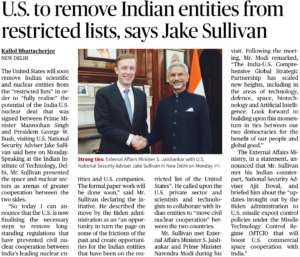
What is a restricted list?
- The restricted list refers to a list of entities and individuals in certain countries, including India, that face trade or cooperation restrictions, particularly in sensitive areas like nuclear technology and scientific advancements.
- These restrictions prevent U.S. companies and government entities from engaging in civil nuclear cooperation or providing certain technologies to the listed entities.
- The list was a result of concerns over the proliferation of nuclear weapons and the potential for sensitive technologies being misused.
- For India, many of its leading nuclear and scientific entities have been on this list, hindering full cooperation with the U.S. in civil nuclear and space sectors.
- Recent policy shifts aim to remove these entities from the list to foster greater collaboration in these areas.
Benefits for India:
- Enhanced access to advanced U.S. nuclear technology, fostering growth in India’s civil nuclear sector.
- Improved collaboration with U.S. scientific and technological institutions, boosting India’s research capabilities.
- Increased opportunities for joint ventures and partnerships between Indian and U.S. companies, particularly in space, defense, and nuclear sectors.
- Greater access to U.S. expertise and resources in the development of clean energy solutions, contributing to India’s energy goals.
- Expansion of commercial space cooperation, benefiting India’s space programs through enhanced technology sharing and collaboration.
- Facilitation of India’s participation in global nuclear governance frameworks, improving its standing on the global stage.
- Accelerated innovation and technological development in critical sectors like biotechnology and AI.
USPC Mains Practice Question
Ques : Examine the potential implications of the U.S. decision to remove Indian entities from its restricted lists on bilateral relations and technological cooperation. (250 Words /15 marks)
GS PAPER 2
Prelims Fact
Twigstats is a new method that helps scientists understand the movement and ancestry of ancient populations.
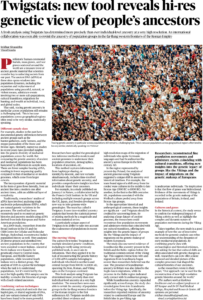
- It provides clearer insights into cultural and genetic changes over time.
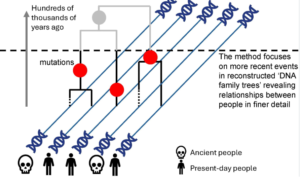
Diagram showing how Twigstats works.
What is Twigstats?
- Twigstats is a new method developed by researchers to study the genetic history of populations.
- It helps scientists trace the ancestry of ancient people and understand how they moved and mixed with other groups.
- This method looks at both shared DNA segments and rare DNA variations to get a clearer picture of population history.
- Twigstats improves the accuracy of genetic studies by reducing errors and increasing the statistical power of existing methods.
- The method can analyze large sets of ancient DNA samples and create detailed maps of population movement and ancestry.
- It has been tested on ancient DNA samples from Europe, especially from the Viking Age, to study migration patterns.
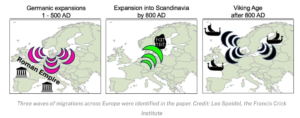
- By using Twigstats, researchers can better understand how cultural and genetic changes happened over time.
- It offers a more precise way to reconstruct the past and track the movement of ancient populations.
GS PAPER 3
Indian Polity
On January 6, Tamil Nadu Governor R.N. Ravi left the Legislative Assembly without delivering his customary address after the National Anthem was not played before his scheduled address.
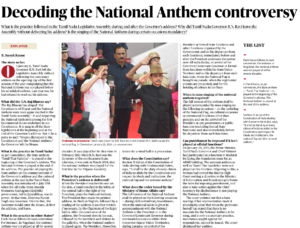
- The Governor had previously refused to read out his address last year as well under similar circumstances.
Raj Bhavan’s Allegations
- The Tamil Nadu Raj Bhavan claimed that “the Constitution of Bharat and the National Anthem were once again insulted in the Tamil Nadu Assembly.”
- It emphasized that respecting the National Anthem is a fundamental duty enshrined in the Constitution.
Tamil Nadu’s Practice Regarding Anthems
- In Tamil Nadu, the State anthem, ‘Tamil Thai Vazhthu,’ is played at the beginning of the Governor’s address, and the National Anthem is played at the end.
- This practice was introduced in July 1991 during the AIADMK government led by Jayalalithaa and Governor Bhishma Narain Singh.
- Prior to this, the Governor would enter the House, deliver the address, and leave without playing either anthem.
Practice in Other States
- Different states follow varying conventions. In Nagaland, the National Anthem was played for the first time in February 2021 during Ravi’s tenure as Governor.
- Similarly, Tripura first played the National Anthem in March 2018.
Constitutional Provisions and Legal Practices:
- Constitution of India: Section 51(A)(a) mandates citizens respect the Constitution, National Flag, and National Anthem.
- Ministry of Home Affairs Order: The National Anthem must be played on formal occasions such as civil/military investitures, presidential arrivals, and state functions.
- Judicial Interpretation: The Madras High Court dismissed a petition that sought punishment for not playing the National Anthem at a function in Madurai.
- Supreme Court’s Ruling: There is no legal mandate to play the National Anthem; it is a customary practice, not a compulsory act.
- No Legal Consequence: The court emphasized that failing to play the National Anthem does not warrant legal action.
USPC Mains Practice Question
Ques : Examine the constitutional provisions and practices related to the playing of the National Anthem in official functions and their legal implications in India. (150 Words /10 marks)
GS PAPER 4
Social Justice – Health & Science and Technology
China is piloting a pneumonia monitoring system due to rising infections, with human metapneumovirus detected in children under 14.
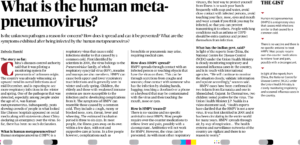
- Social media reports on crowded hospitals, but no health emergency has been declared in China.
What is Human Metapneumovirus (HMPV)?
- Human metapneumovirus (HMPV) is a respiratory virus that causes mild cold-like symptoms, such as cough, fever, sore throat, and runny nose.
- It was identified in 2001 and belongs to the Pneumoviridae family, which includes respiratory syncytial virus (RSV).
- The virus can lead to upper and lower respiratory tract infections, particularly in children, the elderly, and those with weak immune systems.
- While most cases resolve with rest, complications like bronchitis or pneumonia may require medical care.
Spread and Treatment of HMPV
- HMPV spreads through respiratory droplets and contact with contaminated surfaces.
- There is no vaccine or specific antiviral treatment; supportive care is used for symptom relief.
- Preventive measures include handwashing, avoiding close contact, and wearing masks.
India’s Response
- The National Centre for Disease Control (NCDC) is monitoring respiratory infections, including HMPV cases in Karnataka, Gujarat, and Chennai.
- Union Health Minister J.P. Nadda reassured that HMPV is not a new virus and there is no cause for concern.
USPC Prelims Practice Question
Ques : What is Human Metapneumovirus (hMPV)?
(a) A bacterial infection causing pneumonia
(b) A virus associated with respiratory infections
(c) A fungal pathogen affecting the lungs
(d) A genetic disorder affecting immunity
Ans: b)
In News : UJALA: 10 Years of Energy-Efficient Lighting
Launched on 5th January 2015, UJALA aimed to transform household lighting in India by offering affordable energy-efficient LED bulbs, tube lights, and fans.

Introduction and Purpose of UJALA
- Initially known as the Domestic Efficient Lighting Programme (DELP), it later became UJALA, focusing on energy conservation, reducing electrification costs, and cutting carbon emissions.
- Over the last decade, more than 36 crore LED bulbs have been distributed, making India the world’s largest zero-subsidy lighting program.
Need for UJALA and Energy Efficiency
- Traditional lighting systems in India consumed excessive electricity, leading to high costs for consumers. LEDs, offering significant energy savings compared to CFLs and ICLs, were identified as a key solution.
- Prior to UJALA, LED bulbs were expensive, with retail prices ranging from Rs 450-500, making them inaccessible to many.
- Under UJALA, LED bulbs were made available at a subsidized rate of Rs 70 per bulb, drastically reducing the cost and increasing adoption across households.
- LED bulbs use significantly less electricity, consuming just 1 unit for 140 hours, compared to 2 units for CFLs and 9 units for ICLs, resulting in lower energy bills.
UJALA’s Achievements and Impact
- As of 6th January 2025, UJALA has distributed over 36.87 crore LED bulbs, contributing to major reductions in energy consumption and electricity bills for millions of households.
- The program has increased transparency and efficiency through e-procurement and competitive bidding, reducing costs and enhancing market competition.
- Beyond economic savings, the scheme has helped India reduce its carbon footprint, contributing to the nation’s goals of energy conservation and climate change mitigation.
Street Lighting National Programme (SLNP)
- Launched on the same day as UJALA, the Street Lighting National Programme (SLNP) aimed to replace conventional streetlights with LED lights, reducing energy consumption and operational costs for municipalities.
- EESL, the implementing agency, collaborated with urban and rural local bodies to execute the program, relieving municipalities from upfront investment costs through a unique business model.
- By January 2025, SLNP had installed over 1.34 crore LED streetlights, saving 9,001 million units of electricity annually, reducing peak demand by 1,500 MW, and cutting CO₂ emissions by 6.2 million tonnes per year.
Conclusion
- UJALA and SLNP together exemplify the impact of government initiatives in promoting energy efficiency, reducing energy costs, and mitigating environmental damage.
- These programs have transformed India’s lighting sector, helping households and municipalities save costs while fostering a sustainable, energy-efficient future.
USPC Mains Practice Question
Ques : Other than economic savings, discuss the environmental and social impacts of the UJALA scheme and the Street Lighting National Programme (SLNP) in India. (150 Words /10 marks)
GS PAPER 5
Editorial Analysis
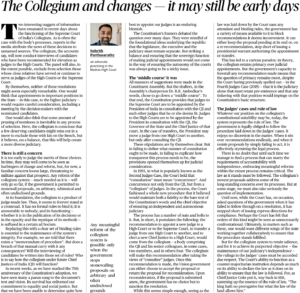
Context :
- The article highlights recent reforms in the Supreme Court Collegium system, including candidate interviews and efforts to promote judicial diversity.
- It also addresses challenges such as government interference and the need for transparency and accountability to ensure judicial independence.
Key Decisions by the Supreme Court Collegium
- Recent reports indicate two decisions by the Supreme Court Collegium:
- Conducting interviews for candidates recommended for elevation as High Court judges.
- Avoiding selection of candidates with close relatives serving or having served as judges in the High Courts or Supreme Court.
- These steps aim to promote transparency and diversity in judicial appointments, though they might exclude some deserving candidates.
Concerns Over Collegium Functioning
- Despite the potential for reform, concerns about the government’s ability to stall recommendations persist.
- The collegium’s processes are criticized for lacking formal rules, transparency, and accountability, relying instead on ad hoc mechanisms.
Constitutional Provisions on Judicial Appointments
- The Constitution mandates judicial appointments by the President in consultation with the Chief Justice of India (CJI) and other relevant stakeholders:
- For Supreme Court judges: Consultation with the CJI and other judges deemed fit.
- For High Court judges: Consultation with the CJI, Governor, and Chief Justice of the High Court.
- The provisions lack clarity on the manner and transparency of consultation, leaving room for interpretation.
Evolution of the Collegium System
- The Second Judges Case (1993) redefined “consultation” as “concurrence,” introducing the collegium system:
- The collegium, comprising the CJI and senior judges, recommends judicial appointments and transfers.
- The government can return recommendations for reconsideration but must accept them if resubmitted.
- The Fourth Judges Case (2015) emphasized the judiciary’s primacy in appointments, asserting that any alteration would violate the Constitution’s basic structure.
Challenges in Implementation
- Despite the judiciary’s declared primacy, the government can stall recommendations by delaying approvals or withholding presidential warrants.
- This paradox undermines the collegium’s authority, despite its basis in the rule of law.
Need for Binding Rules and Reforms
- The absence of formal, binding rules weakens the collegium system.
- Questions remain on whether recent changes, like candidate interviews, will be codified into binding procedures.
- The lack of a clear enforcement mechanism for the “memorandum of procedure” highlights the need for systemic reforms.
Balancing Accountability and Independence
- Judicial independence is critical for the rule of law, yet accountability mechanisms remain insufficient.
- Until a new process emerges, reforms within the collegium system must focus on transparency, rule enforcement, and government compliance.
Way Forward
- The government must respect the rulings in the Judges’ cases to uphold the law and ensure judiciary independence.
- Collaboration between the judiciary and executive is essential to fulfill procedural requirements.
- The judiciary must assert its authority to ensure compliance, fostering confidence in the rule of law.
Conclusion
- Strengthening the Collegium system is vital to uphold judicial independence.
- Transparent, binding rules and government compliance with judicial decisions are essential for sustaining the rule of law in India.
